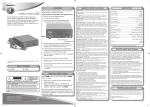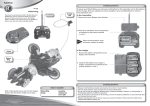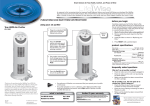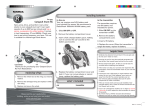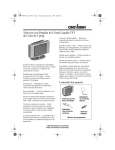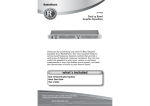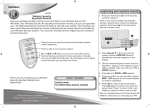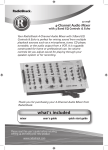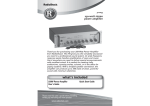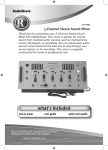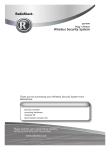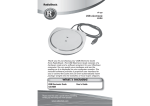Transcript
connections using your modulator 1. Turn on your TV and turn it to Channel 3 or 4 (the one not used for regular broadcasts in your area). 15-2526 RF Modulator 2. Adjust CHANNEL 3/4 on the modulator to the same channel as your TV (3 or 4). Your RadioShack RF Modulator converts audio and video signals from a video camera, DVD player, VCR, or satellite receiver to VHF TV signals to watch on a TV set with no A/V (Audio/Video) inputs. This means you can use it to connect a DVD player to an older TV’s antenna/cable input. The modulator’s gold-plated jacks and terminals assure maximum reliability and minimum signal loss. 3. Turn on the connected video source. The modulator’s green LED lights when it is receiving a signal from an A/V source. 4. To watch TV, turn off the connected video source. If your TV does not return to regular broadcast, disconnect the video source from the modulator. Note: The modulator’s audio output is always mono, even if the source’s audio is stereo. to stereo video Use a stereo A/V cable to connect your modulator to a stereo video source. Connect one end of the cable to the modulator’s VIDEO (yellow) and L/R AUDIO (white/red) jacks. Connect the cable’s other end to your video source’s video and audio output jacks. to monaural video Use an A/V cable to connect your modulator to a mono video source. Connect one end of the cable to the modulator’s VIDEO (yellow) and L/R AUDIO (white/red) jacks. Connect the cable’s other ends to your video source’s video and audio jacks. what’s included RF modulator user’s guide to s-video other parts you will need You need the following parts (not supplied) to connect your modulator to a video input source and your TV: • one audio/video shielded cable. If your video source’s audio output is stereo, use an A/V cable with three phono connectors at each end. If your video source’s audio output is monaural, use an A/V cable with two phono connectors at each end. • two 75-ohm coaxial cables with F-type connectors. • one 75-ohm-to-300-ohm matching transformer (only if your TV does not have a VHF 75-ohm terminal). • one S-Video cable (only if your video source has an S-Video jack). Note to CATV System Installer: This reminder is provided to call attention to article 820-22 of the NEC that provides guidelines for proper grounding and, in particular, specifies that the cable ground shall be connected to the grounding system of the building, as close to the point of cable entry as practical. If your video source has an S-Video jack, use an S-Video cable to connect the modulator’s S-VIDEO jack to your video source’s S-Video jack. If your video source is connected to the modulator’s VIDEO and S-VIDEO jacks, the modulator uses S-video. to tv the FCC wants you to know FCC Declaration of Conformity This device complies with Part 15 of the FCC Rules. Operation is subject to the following two conditions: (1) this device may not cause harmful interference, and (2) this device must accept any interference received, including interference that may cause undesired operation. Product: RF Modulator Model: 15-2526 Responsible Party: RadioShack 100 Throckmorton Fort Worth, TX 76102 Phone: 817-415-3200 The FCC Wants You to Know This equipment has been tested and found to comply with the limits for a Class B digital device, pursuant to Part 15 of the FCC Rules. These limits are designed to provide reasonable protection against harmful interference in a residential installation. This equipment generates, uses and can radiate radio frequency energy and, if not installed and used in accordance with the instructions, may cause harmful interference to radio communications. If your TV is already connected to a VHF input source (cable, antenna, etc.), disconnect the VHF input source from your TV, and connect its cable to the modulator’s ANT IN terminal. Then, use a 75-ohm coaxial cable (not supplied) to connect the modulator’s TO TV terminal to your TV’s 75-ohm VHF/UHF terminal. However, there is no guarantee that interference will not occur in a particular installation. If this equipment does cause harmful interference to radio or television reception, which can be determined by turning the equipment off and on, the user is encouraged to try to correct the interference by one or more of the following measures: If your TV is not already connected to a VHF source, connect a 75-ohm coaxial cable to the modulator’s TO TV terminal to your TV’s 75-ohm VHF/UHF terminal. If your TV has 300-ohm VHF screw terminals, use a 75-ohm-to-300ohm matching transformer to complete this connection. Connect the equipment into an outlet on a circuit different from that to which the receiver is connected. When connections are complete, plug the modulator into a standard AC outlet. Reorient or relocate the receiving antenna. Increase the separation between the equipment and receiver. Consult your local RadioShack store or an experienced radio/TV technician for help. If you cannot eliminate the interference, the FCC requires that you stop using your modulator. Changes or modifications not expressly approved by RadioShack may cause interference and void the user’s authority to operate the equipment. limited 90-day warranty This product is warranted by RadioShack against manufacturing defects in material and workmanship under normal use for ninety (90) days from the date of purchase from RadioShack company-owned stores and authorized RadioShack franchisees and dealers. For complete warranty details and exclusions, check with your local RadioShack store. RadioShack Customer Relations 200 Taylor Street, 6th Floor, Fort Worth, TX 76102 04/04 ©2004. RadioShack Corporation. All rights reserved. RadioShack and RadioShack.com are trademarks used by RadioShack Corporation. 15-2526 07A04 Printed in China important safety instructions Read Instructions — All safety and operating instructions should be read before the product is operated. Retain Instructions — Retain safety and operating instructions for future reference. Heed Warnings — All warnings on the product and in the operating instructions should be adhered to. Follow Instructions — All operating and use instructions should be followed. Cleaning — Unplug this product from the wall outlet before cleaning. Do not use liquid cleaners or aerosol cleaners. Use a damp cloth for cleaning. Attachments — Do not use attachments not recommended by the product manufacturer as they may cause hazards. Water and Moisture — Do not use this product near water, for example, near a bath tub, wash bowl, kitchen sink, or laundry tub; in a wet basement; or near a swimming pool; and the like. Accessories — Do not place this product on an unstable cart, stand, tripod, bracket, or table. The product may fall, causing serious injury to a child or adult, and serious damage to the product. Use only with a cart, stand, tripod, bracket, or table recommended by the manufacturer, or sold with the product. Any mounting of the product should follow the manufacturer’s instructions, and should use a mounting accessory recommended by the manufacturer. Ventilation — Slots and openings in the cabinet are provided for ventilation, to ensure reliable operation of the product and to protect it from overheating. The openings should not be blocked by placing the product on a bed, sofa, rug, or other similar surface. This product should not be placed in a built-in installation such as a bookcase or rack unless proper ventilation is provided or the manufacturer’s instructions have been adhered to. Power Sources — This product should be operated only from the type of power source indicated on the marking label. If you are not sure of the type of power supply to your home, consult your product dealer or local power company. Grounding or Polarization — This product may be equipped with a polarized alternating-current line plug (a plug having one blade wider than the other). This plug will fit into the power outlet only one way. This is a safety feature. If you are unable to insert the plug fully into the outlet, try reversing the plug. If the plug still fails to fit, contact your electrician to replace your obsolete outlet. Do not defeat the safety purpose of the polarized plug. Power-Cord Protection — Power-supply cords should be routed so that they are not likely to be walked on or pinched by items placed upon or against them, paying particular attention to cords at plugs, convenience receptacles, and the point where they exit from the product. Protective Attachment Plug — The product is equipped with an attachment plug having overload protection. This is a safety feature. If replacement of the plug is required, be sure the service technician has used a replacement plug specified by the manufacturer that has the same overload protection as the original plug. Outdoor Antenna Grounding — If an outside antenna or cable system is connected to the product, be sure the antenna or cable system is grounded so as to provide some protection against voltage surges and built-up static charges. Article 810 of the National Electrical Code, ANSI/NFPA 70, provides information on proper grounding of the mast and supporting conductors, location of antenna-discharge unit, connection to grounding electrodes, and requirements for the grounding electrode. Lightning — For added protection during a lightning storm, unplug the unit from the wall outlet and disconnect the antenna or cable system. This will prevent damage to the product due to lightning and power-line surges. Power Lines — An outside antenna system should not be located in the vicinity of overhead power lines, electric light or power circuits, or where it can fall into power lines or circuits. When installing an outside antenna system, take care to keep from touching power lines or circuits. Contact with them might be fatal. Overloading — Do not overload wall outlets, extension cords, or integral convenience receptacles as this can result in a risk of fire or electric shock. Object and Liquid Entry — Never push objects of any kind through product openings as they may touch dangerous voltage points or short parts that could result in a fire or electric shock. Never spill liquid of any kind on the product. Servicing — Do not attempt to service this product yourself as opening or removing covers may expose you to dangerous voltage or other hazards. Refer all servicing to qualified service personnel. Replacement Parts — When replacement parts are required, be sure the service technician uses replacement parts specified by the manufacturer or that have the same characteristics as the original part. Unauthorized substitutions may result in fire, electric shock, or other hazards. Safety Check — Upon completion of service or repairs to this product, ask the service technician to perform safety checks to determine that the product is in proper operating condition. Heat — The product should be situated away from heat sources such as radiators, heat registers, stoves, or other products (including amplifiers) that produce heat.
